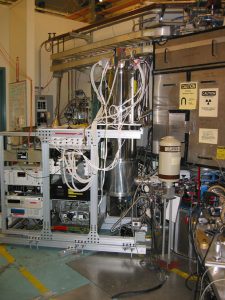Atomic Physics Data for X-Ray Astronomy
K-shell transitions in astrophysically abundant metals and L-shell transitions in Fe group elements show characteristic signatures in the soft X-ray spectrum in the energy range 0.1–10 keV. These signatures have great diagnostic value for plasma parameters such as electron and ion temperatures and densities, elemental abundances, and velocities of the observed material. These signatures can thus help understand the physics controlling the energetic processes in astrophysical sources. This diagnostic power increases with advances in spectral resolution and effective area of the employed X-ray observatories. However, to make optimal use of the diagnostic potential – whether through global spectral modeling or through diagnostics from local modeling of individual lines – the underlying atomic physics has to be complete and well known. With the next generation of soft X-ray observatories featuring micro-calorimeters such as the calorimeter on XARM or the X-IFU on Athena, broadband high-resolution spectroscopy with large effective area will become more commonly available in the next decade. With these spectrometers, the accuracy of the plasma parameters derived from spectral modeling will be limited by the uncertainty of the reference atomic data rather than by instrumental factors. This is sometimes already the case for the high-resolution grating observations with Chandra-HETG and XMM-Newton-RGS. To take full advantage of the measured spectra, assessment of the accuracy of and improvements to the available atomic reference data are therefore important.

Credit: Natalie Hell
The required atomic physics data essentially cover all known atomic physics properties and processes, including energy levels, transition wavelengths and rates, and cross sections for collisional ionization and excitation, autoionization, dielectronic recombination, photoionization and -excitation, radiative recombination, and charge exchange for all of these levels. These rates and cross sections need to be known for the full range of ions from neutral atoms to highly charged ions, where especially the near-neutral ions show a highly complex level structure. The bulk of the data therefore usually stems from theoretical calculations, especially for weak and heavily blended spectral features. These data need to be assessed both through comparisons between calculations, but more importantly by benchmarking the calculations through dedicated measurements in the laboratory. Finally, the data need to be made available and easily accessible to the astrophysics community through comprehensive atomic physics databases. These databases serve as look-up tables for specific parameter values, e.g., to determine temperatures from individual line ratios, on the one hand and to feed physical plasma models on the other hand.
Remeis observatory is involved with several projects covering multiple of these aspects. These include a close collaboration with the developers of AtomDB, an atomic physics database providing a compilation of reference values as well as spectral models focused on collisionally ionized plasmas in- and outside of thermal equilibrium. This effort also includes a push to not only tag each reference value with a measure for its estimated accuracy, but also to make it possible to take such uncertainties of the model into account during spectral fits. Sophisticated routines are being developed for automated (and legible) adding of line labels, drawn from a database, to spectral plots in order to aid with line identification.

Source: https://ebit.llnl.gov/
Additionally, in order to get ready for upcoming X-ray spectroscopy missions, the observatory has a leading role in initiating a coordinated effort in Europe to identify the requirements these missions make on the accuracy and completeness of atomic reference data and to raise awareness in the community for current issues and shortcomings that still need to be addressed. This effort includes a strong collaboration with the EBIT group at LLNL, whose dedicated laboratory astrophysics program has a long and successful history of providing atomic physics reference data and benchmarks for theoretical calculations by measuring these parameters in the well-controlled environment of an Electron Beam Ion Trap using high-resolution spectrometers.



